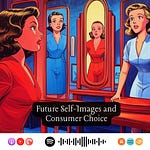Source: Wang, H.S., Yim, C.K.(. Shifting perspectives: How communicating user innovations’ self-focus enhances adoption. J. of the Acad. Mark. Sci. (2024). https://doi.org/10.1007/s11747-024-01068-z
Ready to finally bring that brilliant idea to life in the new year? This podcast episode turns over some research that upends how we market innovations. This isn't about forcing your innovation to fit all customers. It's about recognizing that your own personal needs, the needs that brought your innovation into existence, can be the actual key to mass success. We’re looking at a fascinating study from the Journal of the Academy of Marketing Science that reveals a surprising communication tactic for getting your user-originated innovation adopted by a broad market.
Core Findings
The User Innovation Paradox: Often, innovations come into existence when someone has a very real problem and comes up with a creative way to fix it. That “self-focus” can be a real driver of creativity. But the benefits of the user inventor's solution might not translate very well to others, becoming a barrier to mass adoption.
Counter-Learning Communication: This research suggests that we might try using a communication strategy that goes against the typical grain of how people learn about new things. When you present information that is sequenced in an unusual order, you can actually kick-start the audience's ability to creatively engage with your solution.
Domain Knowledge Is Key: This communication strategy only works well when the potential adopter is reasonably familiar with the area of expertise to which your innovation belongs.
Field Experts (Domain Adopters): For those who already know a bit about your solution's area of expertise, laying out the innovation's attributes (features) before the benefits (goals) inspires them to be creative. They start connecting the dots and imagining their own uses for it.
For Less Experienced Users (Non-Domain Adopters): For users who are less familiar with your innovation's domain of expertise, it’s best to start by laying out the benefits (goals) before the attributes (features). This gives them a good grounding in what's possible before they get into specific details.
Emphasize Your Personal Angle: Instead of hiding that your product was born out of your needs, highlight it. Highlighting your own motivations can actually spark people's interest and drive them to creatively think about how *they* might use it for themselves.
Keep the Spark Alive: Maintaining a "self-focused" approach when you continue to work on your solution (user inventor solo development) is essential. The positive effects of this communication strategy are amplified by the solo user inventor’s continued refinement of the innovation. This is preferred to diluting the original vision by opening up to broad customer feedback early on.
Actionable Takeaways:
Know Your Audience: Prior to launching an innovation, take stock of your target audience’s expertise in the particular domain. Then tailor your messaging accordingly.
Strategic Sequencing: When you're introducing the new thing, play around with which aspects you highlight first: the benefits (why) or the features (how). Experts often want to know the mechanics first. Novices, on the other hand, are most receptive to the big picture first, followed by the nuts and bolts.
Tell Your Story: Avoid shying away from sharing your personal journey. Highlight the real problem your innovation fixed—for you. When others hear this, it can spur their own creativity.
Stay True to Your Vision: While customer input is always useful, you have to take the long view and consider the fundamental character of your self-focused innovation. The thing that makes it special, often, is the unconventionality of the "you" who envisioned it.
Real-World Examples:
The "Powerup Dart": Imagine an app-controlled paper airplane. Hobbyists (domain adopters) probably want to know the technical specs and range. Casual users (non-domain adopters), however, will respond more readily if you start with how fun it is.
The "Perfect" Thermometer: A kitchen thermometer by chefs, for chefs. To reach other professional chefs (domain), talk up the precision and its industrial-grade features. For the home cook, lead with how easy it is to use and how perfect the meals will come out.
A New Year’s Resolution for You: Picture your creation of a habit-tracking app stemming from your struggles with procrastination. To do it right, consider who you're talking to. For experts in productivity, show off those algorithms and data. For everyday people, start with how easy it is to build better habits and finally meet their goals.
This study provides a novel mechanism for launching innovations born from personal passions. By telling the real story of where your idea came from and knowing how well-versed your audience is in the product space, you'll be better positioned to encourage engagement and inspire creative adoption. So as you move through the new year with your innovations, always remember: it’s your particular view of things that can be your greatest asset.














Share this post